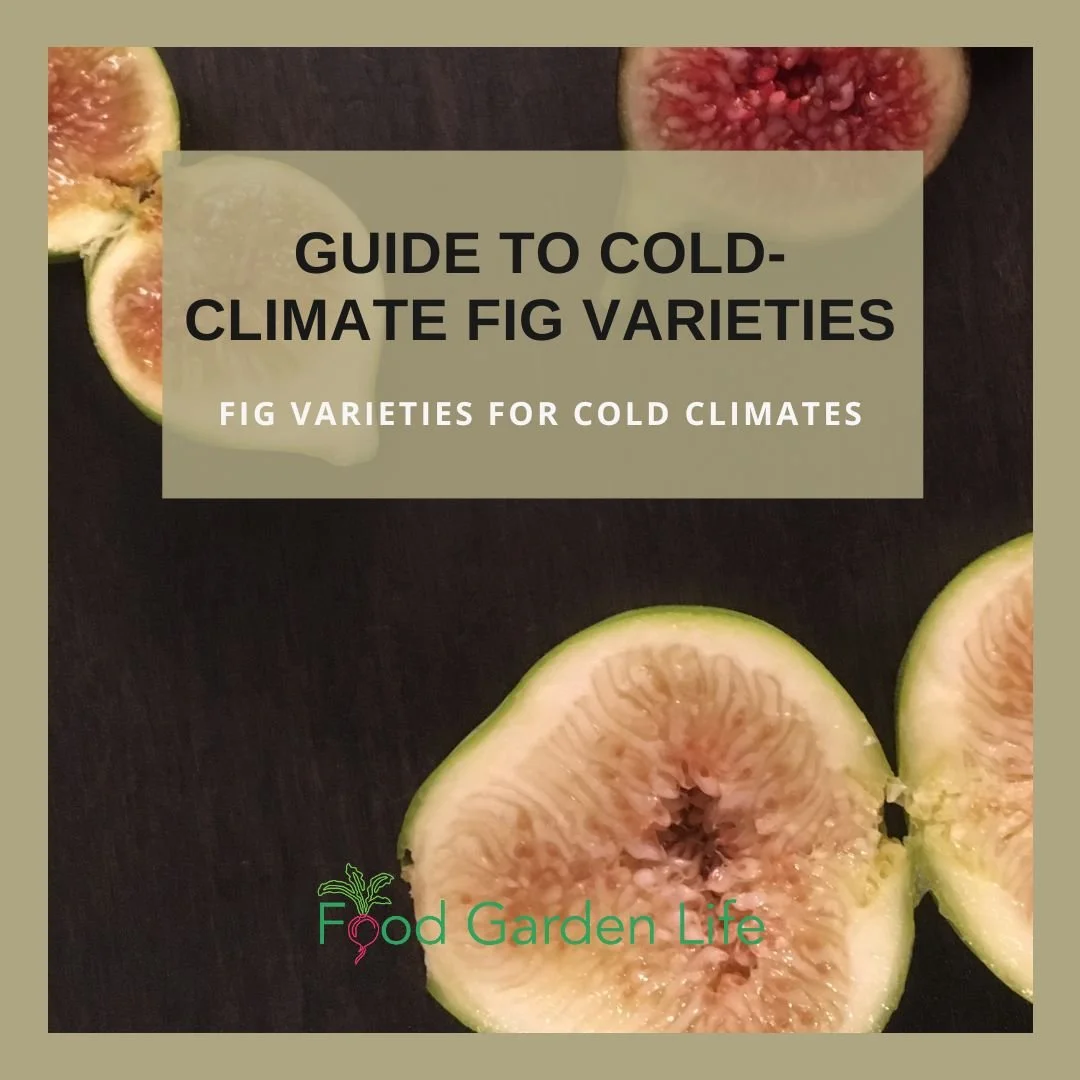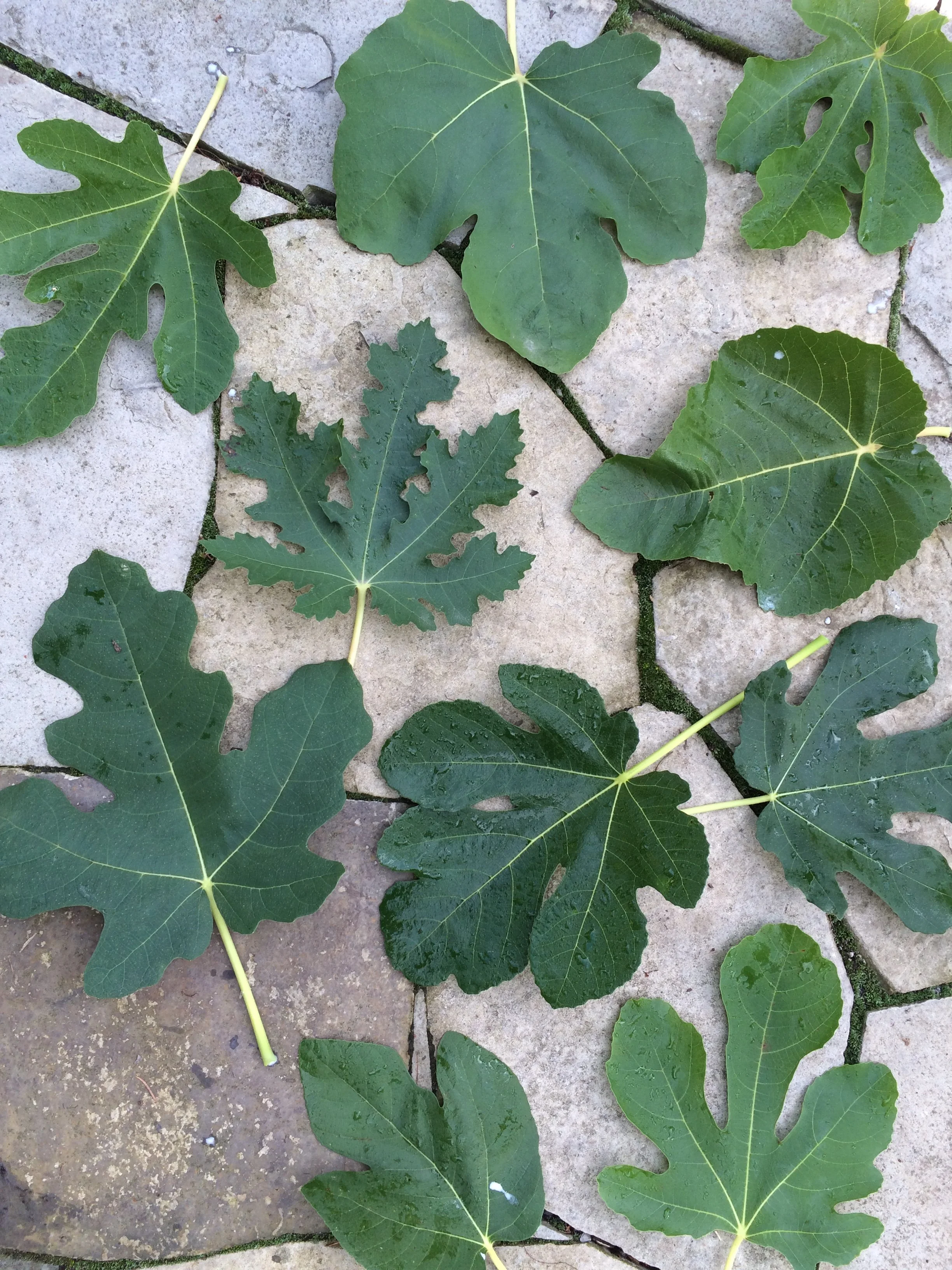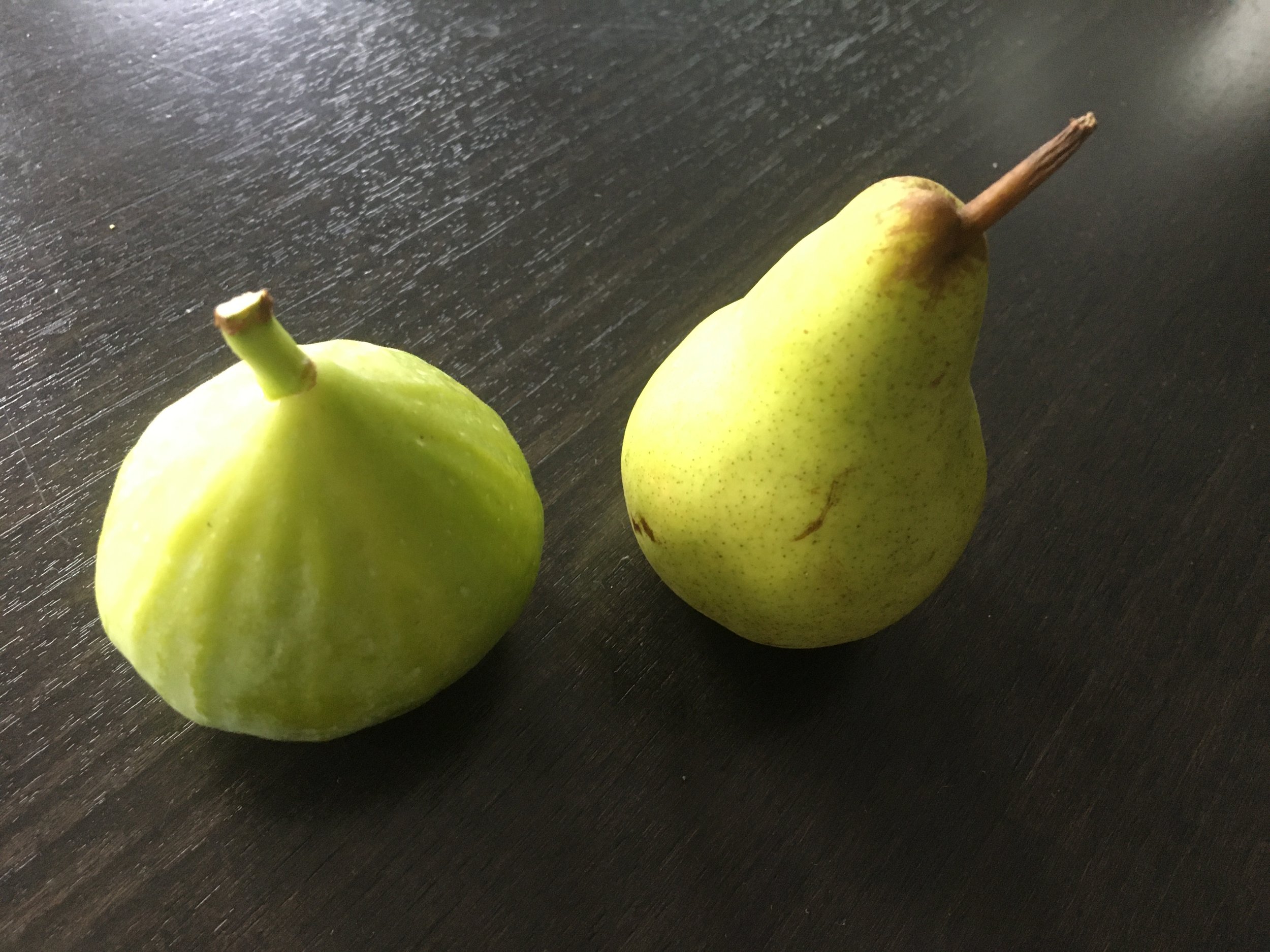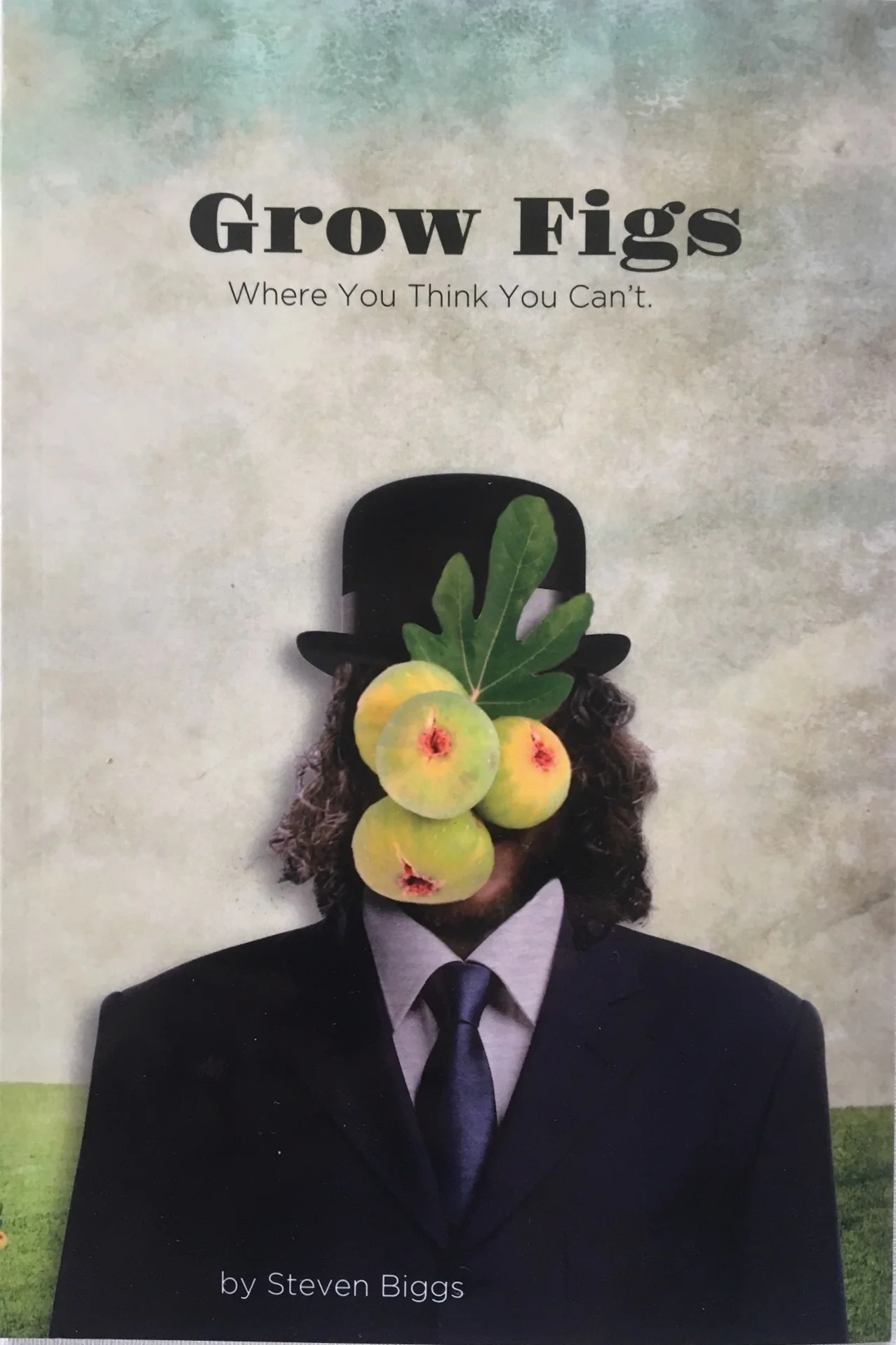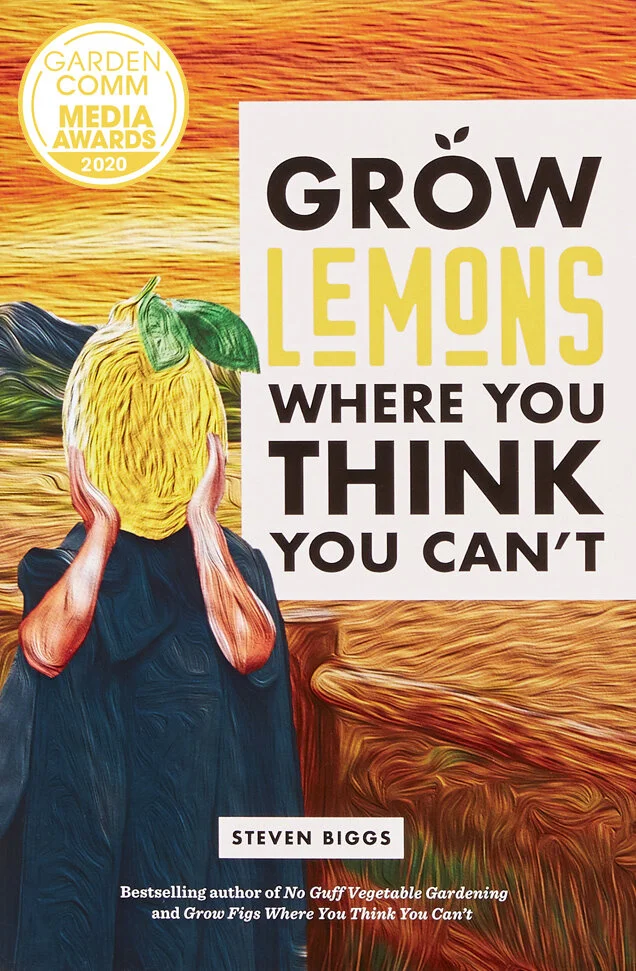By Steven Biggs
Intro to Fig Varieties for Cold Climates
There’s a fig for every taste! But for cold climates, think about varieties that ripen early and have good cold tolerance.
There’s a fig variety for every taste. And a variety best suited to your cold-climate growing conditions and your way of growing figs. Here are things to think of as you consider which variety you’ll grow:
Taste: Some varieties taste more berry-like, while some are more date-like.
Colour: The skin colour can be very dark right through to very light green or yellow. The colour of the flesh inside is also quite variable.
Shape: Shape varies greatly, too, including fruit that are round, oval, pear-shaped or an inverted cone.
Neck: Some fruit have a neck, some don’t.
Size: Some fit in a teaspoon…and some some can almost fill your hand.
Leaf Shape: Leaf shape varies greatly.
Plant Growth: Some varieties grow slowly, some much more quickly.
Top 2 Traits for Cold-Climate Figs
Fig leaf shape depends on the variety.
Here are two top traits that make fig varieties valuable for cold-climate gardeners, who must contend with a short growing season and cold winters:
Ripening Speed: Some varieties grow and ripen fruit in a short window of time.
Hardiness: Some varieties are more cold-hardy than others.
Fig Variety Names
There are many named fig varieties. Things can get confusing because there’s more than one name for many varieties.
There are also many unnamed fig varieties. You’ll come across plants that people call by names such as “Black Greek” or “Italian Red.” If you’re a collector, having named varieties can be important. But if you just want to eat figs from your garden, don’t sweat having a named variety – just focus on something that grows well in your conditions.
Well-Known Fig Varieties
Here are well-know varieties that are often available at garden centres in northern areas:
Ronde de Bordeaux, Top left and centre. It’s both early and flavourful.
Improved Celetste produces small figs with pink flesh and a light-brown skin that becomes violet-brown when ripe.
Desert King. Large crop of breba figs that have green skin and a strawberry-colored flesh. Main crop only matures in areas with the wasp – so the main crop does not ripen in cold areas. (Curious about the wasp? Click here for the article that explains it.)
Excel. Medium-sized sweet, yellow figs with amber flesh.
Hardy Chicago. Very cold tolerant. Small, violet-colored fruit with a red flesh.
Lattarula. Medium-sized, very sweet yellow-green figs with a light-colored flesh. Heavy breba crop.
Ronde de Bordeaux. Early ripening main crop. Purple skin with strawberry colored flesh. Excellent berry flavor.
Find Out How to Grow Your Own Figs
Harvest more figs this year! Grow Figs in Cold Climates Masterclass shows you how to grow a fig tree in a pot, or outside with protection. So you can harvest lots of figs!
Cold-Climate Fig Variety Roundup
We cut this one into 5, so that everybody in the house could enjoy a sliver!
I’ve been lucky enough to chat with a lot of experienced cold-climate fig growers through my communications work and on my radio show. Here are fig variety suggestions from these experts.
Adriano Ferreira
My fig mentor, Adriano had a very big collection in Oakville, Ontario. When I asked him about top varieties, he suggested:
Celeste
Desert King. “The best to grow in a northern climate.”
Lattarula. “A super fig.”
Nelson Esteves
I connected with Nelson when I wrote about figs for Garden Making magazine. He told me about his Mississauga, Ontario collection, with more than 100 varieties. “There are lots of good ones that are ‘unknowns,’ ” he told me. In general, he finds small to medium-sized dark figs do best in northern areas and don’t need as much heat to ripen as light-coloured figs. He suggested:
A dark fig he got from Colasanti Farms in Ruthven—an unnamed variety, he says, that was simply labelled “Italian Fig.”
Hardy Chicago
Paul Khong
I chatted with Paul when I wrote about figs for Garden Making magazine. He’s a collector in Chilliwack, B.C., with more than 100 varieties. He can leave his plants (except for young, tender ones) outside over the winter. He recommended:
Desert King
Osborn’s Prolific
Latarulla
Bob Duncan
Bob runs Fruit Trees and More Nursery near Victoria, B.C. When I’ve visited Bob’s nursery, I’ve come home with a suitcase full of plants!
When it comes to top fig varieties for new fig growers he recommends San Pedro type figs for his Pacific-Northwest climate. (That means main-crop figs won’t fully develop—click here for more about fig types.)
Desert King
Grantham’s Royal
Talking about Grantham’s Royal, Bob says, “It’s one of the largest figs out there.”
Find out how Bob ripens main-crop figs despite the cool summers in the Pacific Northwest.
Ross Raddi
Ross, a.k.a. Fig Boss, grows in Philadelphia, PA. He’s joined me a few times on the radio show to talk about growing figs in cold climates. Here are favourites that he’s shared during our chats:
Improved Celeste
Hardy Chicago
Florea
Longue d’Aout
Violette de Bordeaux
Pastilliere
Jonathan Bates
Jonathan grows figs at his Food Forest Farm in the Finger Lakes region of New York State. He joined me on the radio show to talk about growing figs in cold climates. He recommends finding the “geeks” in your area who are growing lots of varieties instead of testing dozens of varieties yourself. He recommends:
St Rita. Bigger than Chicago Hardy – and earlier.
Florea. His earliest fig.
Improved Celeste
Ronde de Bordeaux. Early, hardy, fast growing.
Bill Lauris
Bill grows in Lancaster, PA, where he runs Off the Beaten Path Nursery. He’s joined me on the radio show to talk figs. He recommends:
offthebeatenpathnursery.com
Teramo. His earliest main-crop fig.
Florea
Longue d’Aout. Big and early.
Maurice
I’ve corresponded with Maurice in Quebec City over the years. I told him I didn’t hold out a lot of hope for his fig harvest because it’s a very short growing season and he’s growing on a balcony with only partial sun.
But he’s persevered, and harvests figs. I’m impressed! After testing a number of varieties, he’s narrowed things down to a couple of favourites:
Ronde de Bordeaux. Does the best for him
Pastiliere. Another good performer
Bob
I’ve corresponded with fig collector Bob in Michigan over the years. He says fig growers in the north need not only cold-hardy figs, but also figs that can mature before the first frost. Here’s what he told me for varieties:
“If your planning on planting figs in ground, in USDA zone 5b, I suggest Danny's Delight, and Sal's EL, for main crop figs. Those two will easily give as many as 200 or more figs per year, even in the north. They can not only take cool summers and still remain sweet, they can also take the rain while they are ripening.”
Ben Nguyen
Ben grows figs in Seattle, WA. He shares his fig-growing adventures on Seattle Garden & Fruit Adventures. He joined me on the radio show to share his favourites. He grows in the Pacific Northwest, where ripening main crop figs can be a challenge.
Vincenzo. Both breba and main crop ripen for him
Pelegrino. Huge, tasty figs
Tony
Tony from Mountain Figs grows in West Virginia. Here are his top picks:
Hardy Chicago. This variety doesn’t give the earliest harvest, but he finds that the plant can ripen figs even if the branches were killed the previous winter (“topkilled”)
Ronde de Bordeaux. The prettiest and earliest.
Florea. Reliable and early.
Improved Celeste. His earliest to harvest.
Brooklyn White. A good light fig.
Michael Bostock
Michael grows figs in Vancouver. He’s experimented with figs for over two decades, and, after many trials, has settled on five varieties that consistently ripen figs in his cool, temperate climate.
At the time we corresponded, winter temperatures had been unusually cold during the previous two winters, dipping down to -14°C (57°F). These colder-than-usual caused some dieback—and gave Michael a good comparison of how well these five varieties tolerate cold.
Here are Michael’s top varieties, in his words:
Desert King. The Pacific Northwest favourite, great taste, and a large crop of brebas. Jammy flavour. Basically unaffected by the last 2 winters.
Dauphine (Grantham’s Royal). Another breba fig, honey flavour, slightly fewer but larger breba than Desert King. Took the first winter OK but must have been weakened since since the second cold winter killed off all top growth. There are some minor suckers growing from low down on the main trunk but very slow. This was trained to a standard. If it comes back I will probably try more of a bush form; I suspect this may be hardier based on my Desert King experience.
Ronde de Bordeaux. Early ripening second-crop fig, great jammy taste. Every once in a while (once in 5-10 years) it produces a large breba crop. My tree was trained to a vase shape. First cold winter (2022) was fine. In 2023, half the tree was fine, the other half had top growth killed but vigorous suckers near the base of the corresponding limbs.
Florea. Earliest ripening second crop, big, honeyish, good fig to have in the few days before Improved Celeste and Ronde de Bordeaux start to ripen as they are better tasting and ripen more rapidly once they start. Always has fungal die back on the youngest branches even in mild winters but always comes back in good form. In a drier climate I hear it can take down to -20°C.
Improved Celeste. Early ripening second-crop fig, very nice honey fig, ripens around same time as Ronde de Bordeaux. Like Dauphine, mine was trained as a standard. It suffered visibly in the first cold winter, half the upper growth was killed. In 2023 it is fully dead down to near the base of the trunk, where some weak attempts at budding have started. This looks to be the weakest of the bunch despite the fact that one of its parents (Celeste) is supposed to be among the hardier figs.
My Favourites Fig Varieties
To wrap things up, here are my favourite fig varieties that I grow here in my Toronto garden.
It’s a race to see who gets to the Sultane fig first in my household!
Ronde de Bordeaux. Consistently early, and a great berry-like taste.
Capelas. I got it from my mentor, Adriano – and think of him when I pick from it. It produces two crops, and consistently ripens the main-crop figs in our short season.
Niagara Black. Really big delicious breba. My neighbour John gave me this…and I LOVE it.
Sultane. Can’t beat it for flavour. I have to try to get to these before the rest of my family.
Excel. A very reliable light fig
More Fig Variety Resources
If you’re still looking for fig variety ideas for your area, see if you can connect with cold-climate fig growers in your area to see what they are growing. There are also lots of online groups and forums.
Click the button below to hear my chat with Joe from OurFigs.com. He talks about the online fig community and how they share top tips and varieties information.
As you come across potential varieties and want more information about them, the Figs4Fun fig variety database is useful.
Still Not Sure Which Variety to Start With?
I know…there are so many to choose from.
I suggest you go through the recommendations above to pick out the fig varieties that a number of people have recommend.
More Fig Information
Fig Home Page
Fig Masterclass
This is a self-paced course all about how to grow figs at home, in a cold climate. Everything you need to successfully harvest figs in a cold climate.
Find Out How to Grow Your Own Figs
Harvest more figs this year! Grow Figs in Cold Climates Masterclass shows you how to grow a fig tree in a pot, or outside with protection. So you can harvest lots of figs!
OR…if you enjoy live event, I run this fig course live, once a year. Hop on my newsletter, below, to get notified when I run it next.

